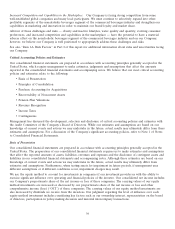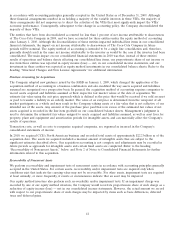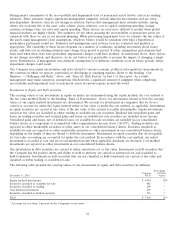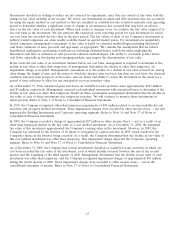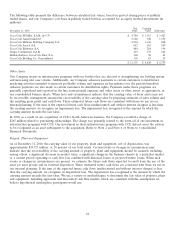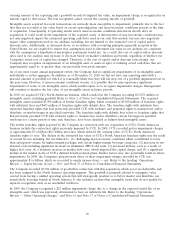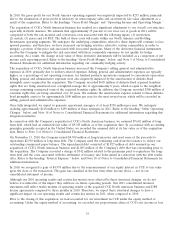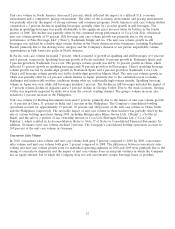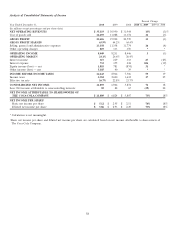Coca Cola 2010 Annual Report Download - page 51
Download and view the complete annual report
Please find page 51 of the 2010 Coca Cola annual report below. You can navigate through the pages in the report by either clicking on the pages listed below, or by using the keyword search tool below to find specific information within the annual report.Income Taxes
Our annual tax rate is based on our income, statutory tax rates and tax planning opportunities available to us in the
various jurisdictions in which we operate. Significant judgment is required in determining our annual tax expense and in
evaluating our tax positions. We establish reserves to remove some or all of the tax benefit of any of our tax positions
at the time we determine that the positions become uncertain based upon one of the following: (1) the tax position is
not ‘‘more likely than not’’ to be sustained, (2) the tax position is ‘‘more likely than not’’ to be sustained, but for a
lesser amount, or (3) the tax position is ‘‘more likely than not’’ to be sustained, but not in the financial period in which
the tax position was originally taken. For purposes of evaluating whether or not a tax position is uncertain, (1) we
presume the tax position will be examined by the relevant taxing authority that has full knowledge of all relevant
information, (2) the technical merits of a tax position are derived from authorities such as legislation and statutes,
legislative intent, regulations, rulings and case law and their applicability to the facts and circumstances of the tax
position, and (3) each tax position is evaluated without considerations of the possibility of offset or aggregation with
other tax positions taken. We adjust these reserves, including any impact on the related interest and penalties, in light
of changing facts and circumstances, such as the progress of a tax audit.
A number of years may elapse before a particular matter for which we have established a reserve is audited and finally
resolved. The number of years with open tax audits varies depending on the tax jurisdiction. The tax benefit that has
been previously reserved because of a failure to meet the ‘‘more likely than not’’ recognition threshold would be
recognized in our income tax expense in the first interim period when the uncertainty disappears under any one of the
following conditions: (1) the tax position is ‘‘more likely than not’’ to be sustained, (2) the tax position, amount, and/or
timing is ultimately settled through negotiation or litigation, or (3) the statute of limitations for the tax position has
expired. Settlement of any particular issue would usually require the use of cash.
Tax law requires items to be included in the tax return at different times than when these items are reflected in the
consolidated financial statements. As a result, the annual tax rate reflected in our consolidated financial statements is
different than that reported in our tax return (our cash tax rate). Some of these differences are permanent, such as
expenses that are not deductible in our tax return, and some differences reverse over time, such as depreciation
expense. These timing differences create deferred tax assets and liabilities. Deferred tax assets and liabilities are
determined based on temporary differences between the financial reporting and tax bases of assets and liabilities. The
tax rates used to determine deferred tax assets or liabilities are the enacted tax rates in effect for the year and manner
in which the differences are expected to reverse. Based on the evaluation of all available information, the Company
recognizes future tax benefits, such as net operating loss carryforwards, to the extent that realizing these benefits is
considered more likely than not.
We evaluate our ability to realize the tax benefits associated with deferred tax assets by analyzing our forecasted taxable
income using both historical and projected future operating results, the reversal of existing taxable temporary
differences, taxable income in prior carryback years (if permitted) and the availability of tax planning strategies. A
valuation allowance is required to be established unless management determines that it is more likely than not that the
Company will ultimately realize the tax benefit associated with a deferred tax asset. As of December 31, 2010, the
Company’s valuation allowances on deferred tax assets were $950 million and are primarily related to uncertainties
regarding the future realization of recorded tax benefits on tax loss carryforwards generated in various jurisdictions.
Current evidence does not suggest we will realize sufficient taxable income of the appropriate character (e.g., capital
gain versus ordinary income) within the carryforward period to allow us to realize these deferred tax benefits. If we
were to identify and implement tax planning strategies to recover these deferred tax assets or generate sufficient income
of the appropriate character in these jurisdictions in the future, it could lead to the reversal of these valuation
allowances and a reduction of income tax expense. The Company believes that it will generate sufficient future taxable
income to realize the tax benefits related to the remaining net deferred tax assets in our consolidated balance sheets.
The Company does not record a U.S. deferred tax liability for the excess of the book basis over the tax basis of its
investments in foreign corporations to the extent that the basis difference results from earnings that meet the indefinite
reversal criteria. This criteria is met if the foreign subsidiary has invested, or will invest, the undistributed earnings
indefinitely. The decision as to the amount of undistributed earnings that the Company intends to maintain in non-U.S.
subsidiaries takes into account items including, but is not limited to, forecasts and budgets of financial needs of cash for
working capital, liquidity plans, capital improvement programs, merger and acquisition plans, and planned loans to
other non-U.S. subsidiaries. The Company also evaluates its expected cash requirements in the United States. Other
49


